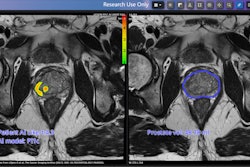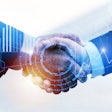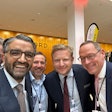Establishing an institutional AI board with a linked patient and public involvement and experience (PPIE) group, along with creating an open-source platform Extensible Neuroimaging Archive Toolkit (XNAT) virtual PACS environment, has helped to guide safe and effective AI implementation in radiology at a large U.K. university hospital group.
"These measures have laid the groundwork for ongoing innovation, industry partnerships, and continuous improvement in patient outcomes and service delivery," noted Dr. James Cairns, radiology registrar and National Institute for Health and Care Research academic fellow in clinical radiology, and colleagues at Leeds Teaching Hospitals National Health Service (NHS) Trust. "The AI board will be instrumental in the future delivery of services driven by AI at our institution."
Incorporating AI into routine medical care requires significant organizational transformation, encompassing not only technology adoption but also effective navigation of ethical, legal, and privacy issues that are inherent in AI applications, they explained in an e-poster presentation at ECR 2024 that received a cum laude award. The authors described their approach to creating "an ecosystem for imaging AI tool development, prioritization, evaluation, and patient acceptability."
The primary function of the AI board is to coordinate, supervise, and assess all practical implementations and ensure a comprehensive strategy for integrating technologies. The panel consists of clinical radiologists, radiographers, AI experts from academic and medical image analysis fields, health economists, IT and information governance personnel, and hospital management. Patient viewpoints are incorporated and considered in relation to clinical deployment of AI.
 Outcomes from the half-day AI board prioritization workshop. Figures courtesy of Dr. James Cairns et al and presented at ECR 2024.
Outcomes from the half-day AI board prioritization workshop. Figures courtesy of Dr. James Cairns et al and presented at ECR 2024.
Alongside regular board meetings, a half-day in-person workshop was held in July 2023 to identify priority clinical use cases for imaging AI at Leeds. Participants consisted of members of the AI board with contributions from clinicians, IT specialists, radiography professionals, the Association of British HealthTech Industries (ABHI), and patient representatives.
An essential component involves modifying and employing a matrix derived from a previously published scoring tool, the authors wrote. No guidance currently exists to assist hospitals with decision-making on which AI product to implement, so the scoring matrix fulfills this unmet need and involves weighted scoring with guidance for key domains such as clinical impact, scientific evidence, workflow impact, ease of use, risk of harm, local performance, maintenance, and monitoring.
 Illustration of the Leeds Teaching Hospitals NHS Trust XNAT server architecture.
Illustration of the Leeds Teaching Hospitals NHS Trust XNAT server architecture.
Datasets are required to train, validate, and evaluate AI algorithms, they continued. "This involved establishment of a secure virtual PACS server using the open-source platform XNAT. This server, when combined with local clinical expertise facilitates the extraction of rich, representative datasets from our institutional PACS."
Data are anonymized/pseudonymized using an embedded script in the XNAT software, ensuring safe storage onsite. Also, work is progressing with the implementation of an AI deployment engine coupled to this server to allow the efficient implementation of AI tools. Active collaboration with industry partners has been crucial in aligning AI development with specific clinical requirements, thus expediting the integration of AI technology.
Unified approach
The AI board has overseen the evaluation of all imaging-related initiatives, providing a unified and standardized approach to AI implementation, the authors stated. "This is vital in overcoming commonly experienced barriers with the implementation of AI, such as streamlining complex, time-consuming information governance approval, upgrading highly variable IT infrastructure, increasing awareness of the transformative potential of AI, and securing funding through industry collaboration."
The AI board was originally conceived by AuntMinnieEurope.com columnist Dr. Chris Hammond, a consultant vascular radiologist and clinical director for radiology at Leeds. Several key domains were identified for applying AI, such as staff education, request vetting, quality assurance, image interpretation, and patient communication. Commercially available AI products were mapped against priority areas identified.
"The setup of an XNAT virtual PACS 'sandbox' environment with an AI deployment engine has played a crucial role in enabling efficient retrospective and prospective benchmarking of AI tools. These evaluations are necessary for assessing the efficacy of AI in improving workflow efficiency and diagnostic accuracy prior to clinical deployment as there can be a gap between legal certification and local clinical performance," the authors wrote.
Industry collaboration has been instrumental in leveraging artificial intelligence to enhance radiological operations and patient care. A deal with Lucida Medical is being explored as part of a Topol Fellowship feasibility project to assess the role of AI in triaging prostate cancer patients, and they've received funding to evaluate radiology AI products from Aidoc, Qure.AI, and Radiobiotics. Also, industry-academic collaborations with Mirada Medical and Oxford Heartbeat have been secured from Innovate UK.
The result is the creation of AI specifically tailored for real applications, they said. For example, employing AI-assisted PET-CT interpretation in lymphoma treatment response assessment, which has demonstrated the potential to reduce interpretation time without compromising accuracy.
While there is strong clinical support for the scheme, insufficient allocation of IT resources can limit progress. The AI board has allowed clinicians to collaborate and produce efficient solutions to streamline allocation of limited resources and navigate this issue, according to the authors.
For further reading, they recommend the Royal College of Radiologists' document, "Overcoming Barriers to AI Implementation in Imaging: Outcome of an RCR Expert Stakeholder Day 2023." See RCR website for more details.
The coauthors of the e-poster were Dr. Beverley Riley, Hanif Ismail, Dr. Bashar Al-Qaisieh, Mohua Siddique, Christopher Herbert, Bob Wheller, Dr. Fahmid Ul-Haque Chowdhury, and Prof. Andrew Scarsbrook.



















